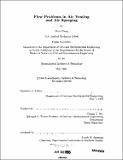| dc.contributor.advisor | Chiang C. Mei. | en_US |
| dc.contributor.author | Cheng, Zhao, 1969- | en_US |
| dc.date.accessioned | 2005-08-19T18:47:09Z | |
| dc.date.available | 2005-08-19T18:47:09Z | |
| dc.date.copyright | 1998 | en_US |
| dc.date.issued | 1998 | en_US |
| dc.identifier.uri | http://hdl.handle.net/1721.1/9593 | |
| dc.description | Thesis (S.M.)--Massachusetts Institute of Technology, Dept. of Civil and Environmental Engineering, 1998. | en_US |
| dc.description | Includes bibliographical references. | en_US |
| dc.description.abstract | Soil Vapor Extraction (SVE) and Air Sparging have been used for site remediation for about ten years, but most of the past designs are based on experiences and numerical models. Understanding toward the physical problems is far from complete, and some simplified assumptions used in those models may not be true. In this thesis, we focus our attention on the hydrodynamic problems in SVE and air sparging. In Chapter One some basic concepts related to the fl.ow problem in the porous media such as soil are introduced, and previous models for SVE and air sparging are reviewed in some detail. The SVE model is derived in Chapter Two. Specifically we examine the water table rise during SVE. In Chapter Three, A mathematical model for steady state air sparging is describe. Unlike previous models(Van Dijke et al, 1995), the air phase compressibility is accounted for. Numerical methods are used to solve the governing equations. Results are compared with two dimensional laboratory experiment(Ji et al, 1993) and field data(Lundegard, 1995). The most important parameter in air sparging system design is the Radius Of Influence(ROI) of the sparging well{McCray 1997). Computations are performed to reveal the relationship between ROI of a sparging well to other parameters such as air sparging pressure, well screen length, soil properties etc,. Air sparging is typically used in conjunction with a soil vapor extraction system to collect the volatilized compounds above the water table. The use of air sparging results in a net positive pressure in groundwater, and can lead to contaminant migration to previously uncontaminated areas. In Chapter Four, we discussed the coupling effects of SVE and air sparging system. Some interesting phenomena are revealed and discussed. | en_US |
| dc.description.statementofresponsibility | by Zhao Cheng. | en_US |
| dc.format.extent | 12, 141 leaves | en_US |
| dc.format.extent | 8423290 bytes | |
| dc.format.extent | 8423048 bytes | |
| dc.format.mimetype | application/pdf | |
| dc.format.mimetype | application/pdf | |
| dc.language.iso | eng | en_US |
| dc.publisher | Massachusetts Institute of Technology | en_US |
| dc.rights | M.I.T. theses are protected by copyright. They may be viewed from this source for any purpose, but reproduction or distribution in any format is prohibited without written permission. See provided URL for inquiries about permission. | en_US |
| dc.rights.uri | http://dspace.mit.edu/handle/1721.1/7582 | |
| dc.subject | Civil and Environmental Engineering | en_US |
| dc.title | Flow problems in air venting and air sparging | en_US |
| dc.type | Thesis | en_US |
| dc.description.degree | S.M. | en_US |
| dc.contributor.department | Massachusetts Institute of Technology. Department of Civil and Environmental Engineering | en_US |
| dc.identifier.oclc | 42191366 | en_US |
